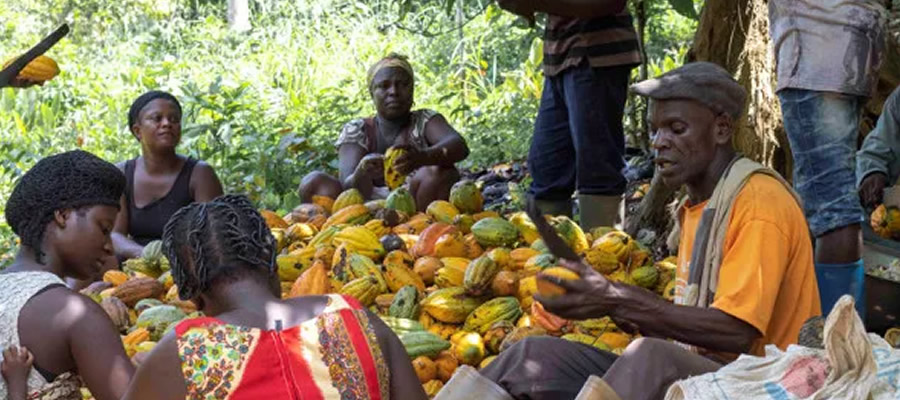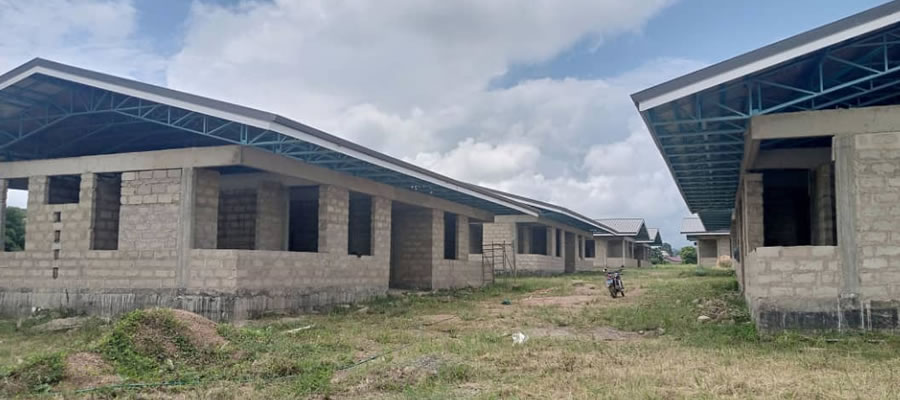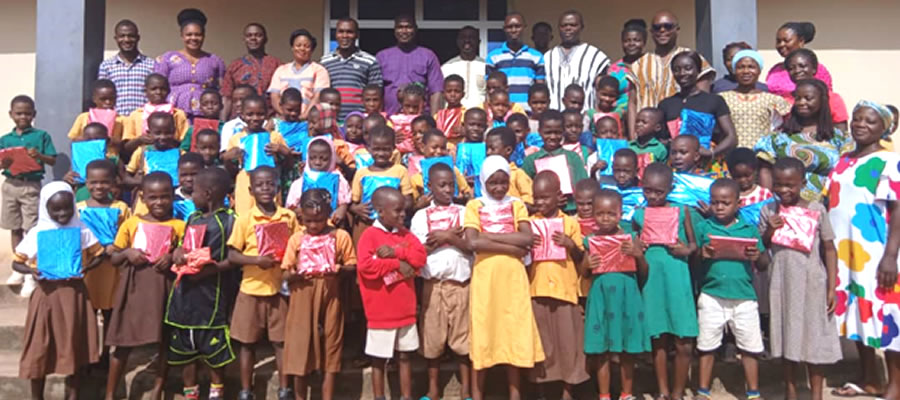

Agriculture production is the predominant sector of the District economy in terms of employment opportunities and incomes. The residents of the district who are predominantly rural, provide the maximum contribution to the district’s share of food security. Agriculture production is, however, small-scale and characterized by low out put per farmer.
Farming Methods:
The climate of Kadjebi District encourages two (2) farming seasons. The slash and burn method is employed during the major season. The minor season does not permit burning. Currently the "zero-tillage" method is becoming popular among vegetable farmers. The land is cleared, burnt and hoed to make beds or ridges for vegetable cropping.
Kadjebi District is a high potential aqua culture area with a high level of farming interest. Aqua cultural activities started in 1995 with four (4) farmers. The MOFA, in collaboration with the VSO, the Sakofa Programme (an NGO) and the Kadjebi District Assembly has since placed high priority on its development on account of its potential for contributing to food security income generation and employment.
It is an activity that fits well into the existing farming systems within the district. The availability of abundant land and water resources, the under utilized agricultural -by-products to serve as fish feed ingredient and a strong extension services and Institutional support from MOFA are factors very conducive to promote further development of aqua culture in the district.
Eleven (11) years of operation has yielded the following results:
(i) Establishment of 52 fishponds on a total land area of 2.6 hectares with 45 fish farmers.
(ii) Construction of a fish hatchery at Konsuaso for Fingerling production
(iii) Formation of a viable Fish Farmers Association
(iv) Training of three (3) pond construction gangs in the District.
Problems facing Aqua cultural Activities:
(i) Lack of credit facility to expand Aqua culture operations
(i i) Poor fish pond management
(iii) Poor sitting and seasonably of ponds
(iv) Inability of farmers to take full advantage of available resources
Animal Husbandry:
A few heads of cattle are found around Kadjebi and Ahamansu in the district. Small ruminants, mainly sheep and goats are common in the district. Traditionally, most farmers who rear livestock do so as a minor occupation. Generally, every household keeps a small number of livestock either to serve a source of dietary protein particularly during important occasions or to be marketed when matured to augment the household in-comes.
The field survey revealed that food -producing areas within the District are not easily accessible by vehicular transport. These areas Include Olobobi, Bisakrom, Tarikorkor, Bethel, Koru, Asuboe and Butabe. According to the District Agriculture directorate, feeder roads in some of the areas only lack simple bridges across streams and rivers. Roads are bush track, which are also badly eroded and cannot provide access to vehicles, power tillers and trailers.
The poor road conditions have resulted in the transportation of food by head portage in most parts of the District. Furthermore the transport of agriculture produce by head portage is expensive. It is therefore restricted to goods of small quantities that could be transported at a time. This results into high post harvest loses and encourages farmers to further reduce the size of their holdings.
Freight Charges:
Due to the bad nature of existing feeder roads in the District, freight charges for agriculture products are very high. Many farmers are therefore forced to sell their products by roadsides instead of in the markets where they may receive competitive prices.
It is important to maintain these roads regularly to facilitate effective transportation of Agriculture produce from the hinterlands to the market centres. The construction of these roads will open up areas for the promotion of agriculture in the district.
Post Harvest Activities:
A lot of farming education on post harvest management of farm produce has been carried out through Extension activities of the agriculture Directorate in the district. Awareness on chemical treatment of grains and cereals against storage pests is very high. Cassava rotting in the farms is now rare as processing of the cassava into gari, dough and tapioca is being encouraged.
There are migrant processors who now move from place to place to buy cassava for processing. The preservation of grain and cereals is, however, not effective in the major season due to high humidity. The introduction of mechanical driers in the major season will therefore boost production.
There are farmers Associations/Groups including rice, plantain, livestock, maize farmers and vegetable growers. These Farmers Based Organizations have been registered in the district but only a few of them are active.
Existence of Credit Facilities:
Credit is available to viable farmers groups in the district under FABs and FBODF. Sankofa/Action Aid provides micro-credit to Some selected individual farmers. The Banks in the district do not have any known production credit scheme for farmers.
Agriculture extension agents (AEA) offer extension services free to farmers. There are only nine (9) AEAs instead of the required nineteen (19) to play this role successfully. The AEA farmer ratio is 1:3,000 in the district. Sensitization and education on HIV/AIDS has become an integral part of the extension delivery
Schools in Agriculture:
The Kadjebi District is basically agricultural. Therefore the majority of schools in the district are engaged in agricultural activities of some kind. The second cycle schools, Kadjebi-Asato and the Dodi-Papase Senior Secondary School, and some first cycle school as Hamansu R. C., Akum L. A. and Dapaa L. A. Junior Secondary schools are at the forefront of agricultural activities
Cash Crops:
The main cash crop produce in the district is cocoa. The cocoa industry was dominant long ago but has declined and is given way to food crop production as the dominant agriculture activity in the district.
Productivity level in the cocoa industry has also fallen and currently out put per hectare for the crop is between 5 to 10 maxi bags. This does not compare favourably with achievable yields of 10-16 maxi bags per hectare if improved varieties are cultivated. Presently, three (3) cocoa nurseries established at Ampeyo, Dzindziso and Ahamansu are rising. Seedlings for farmers all over the district to reactivate their abandoned cocoa farms.
Also there is an oil palm nursery established at Ahamansu under the Presidential Special Initiative Scheme to produce oil palm seedlings for interested farmers. The first phase of the programme begins in June 2006.
Non Agricultural Sector
The Agriculture Department is currently located in a permanent building at Kadjebi.The Agriculture Department of the District Assembly has its policy to increase food production, create food security, and prevent the entry of crop and livestock diseases along it borders.
In addition to the prevention of the spread of diseases through treatment, plant protection and regulatory practices and livestock vaccination. The Department also ensures wholesomeness of meat for public consumption.
Staff Strength:
The staff strength of the District Agric Office stood at 33 at the end of 2005. These include 24 professionals and eight (8) Administrative staff. The professional staff includes a Chief Production Officer, a Chief Technical Officer, an Assistant Agricultural Officer and a Principal Technical Officer (Veterinary).
Date Created : 11/21/2017 5:35:59 AM










 facebook
facebook
 twitter
twitter
 Youtube
Youtube
 +233 593 831 280
+233 593 831 280 0800 430 430
0800 430 430 GPS: GE-231-4383
GPS: GE-231-4383 info@ghanadistricts.com
info@ghanadistricts.com Box GP1044, Accra, Ghana
Box GP1044, Accra, Ghana